1K0MM - The Kingdom of North Barchant
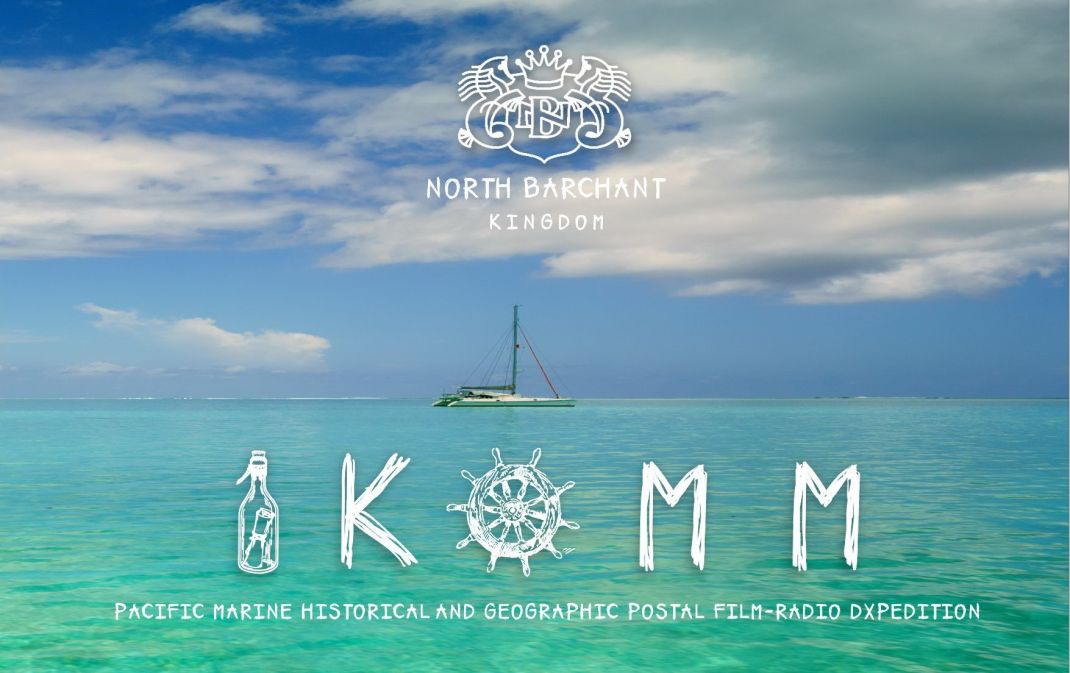
1K0MM – THE KINGDOM OF NORTH BARCHANT
Today the world becomes multipolar, and virtual states shape a new social phenomenon. A virtual independent and sovereign state was established – the Kingdom of North Barchant (hereinafter KNB), which nowadays has its constitution, coat of arms, flag, hymn, passport, currency, postage-stamp. Also, its departments are active. The independence of the virtual state KNB was declared on September 15, 2015, due to a referendum. The political system of KNB is a dualist constitutional monarchy similar to the political system of such countries as Liechtenstein, Kuwait, Morocco, and Bahrain. Currently, Anna Macco, whose legitimacy is by the parliament and people, is the head of the state KNB
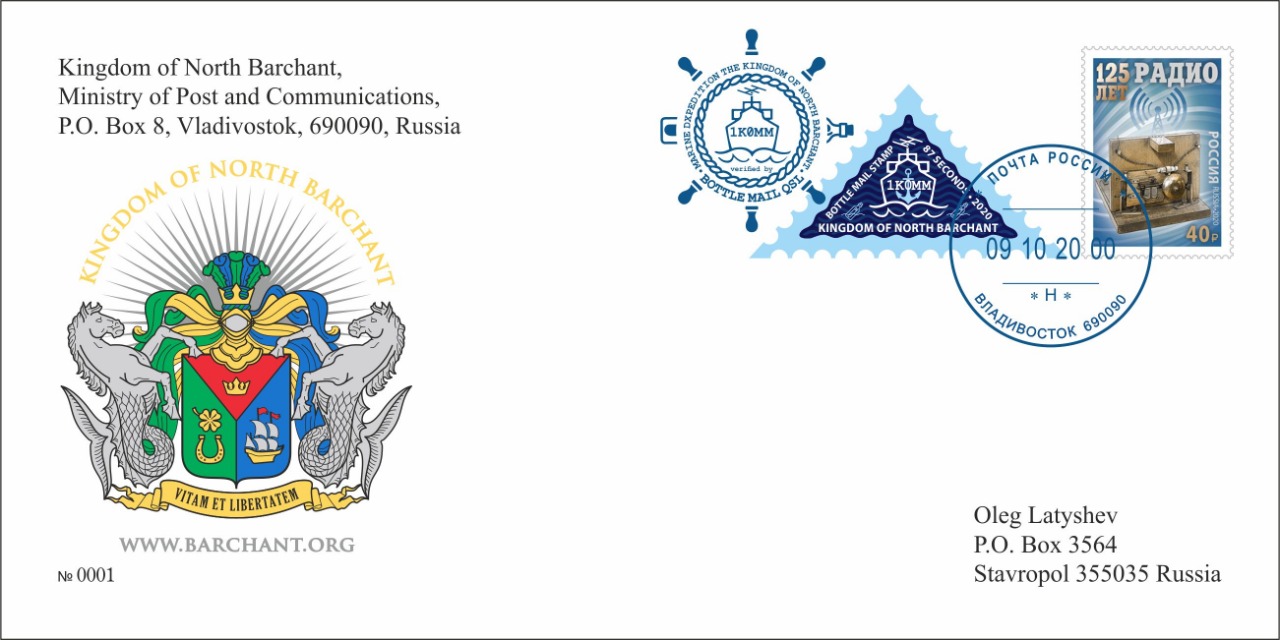
The citizens of KNB and their philosophy
The citizens of KNB are multinational people. Recognizing themselves a part of the world community, having no land and territory and no claiming them, they assert their rights for informational, virtual and other modes of interaction and communications, for transfer of any data and free information by the means of already existing technology and that will be created later on, as well as for shaping noosphere.
The citizens of KNB, people with a new outlook, with their own positive view and goodwill declaring their values, rights and ideas, consider the Constitution of KNB unique and embodying their outlook on life. By rejecting the outmoded dogmas of state regulation and structure, gaining the support of the Constitution of KNB, the citizens of KNB declare belief in the right and justice, the firmness of man’s rights and freedoms both for current citizens of KNB and its future generations.
The sea history of the origins of the virtual state KNB
KNB appeared due to the selfless work of a group of people who took part in rescuing a crew of sailors who got into hot water in May, 2020. Their ships were left with no support in the waters of the Atlantic Ocean. A team of international volunteers and human rights activists took the part in the fate of the sailors and solving their problems. As a result of volunteers’ well-coordinated work, the sailors could go back home. Just then the idea of creating a new state as a fully-featured platform for protecting the rights and rallying the people started up.
The flag of KNB.
The flag of KNB is a three-color cloth of blue, red and green colors with a gold crown representing monarchy. The red triangle is a symbol of courage. The blue stripe represents the waters of the ocean washing the symbolic territory of KNB, the green stripe represents faith and hope.
The coat of arms of KNB
The coat of arms of KNB is a picture of a shield at the background of the rays of the rising sun with a picture of royal power symbols in it – crown, sailing frigate and golden. Mythical hippocampi support the shield from both sides. There’s a Latin inscription at the bottom of the coat of arms – Vitam et libertatem, indicating the principles lying at the heart of the political power of the Kingdom of North Barchant – Life and Freedom.
1K0MM call signal legality.
Every state or separate territory has its radio amateur prefix, which is under the jurisdiction International Telecommunication Union (hereafter ITU) – a specialized body of the UN. This organization defines recommendations in the area of telecommunication and wireless, as well as regulates the issues of international use of radio frequencies. Since KNB is not a member of ITU, and the pool of prefixes in the 1AA-1ZZ series is not active in the ITU coordinates, the Post and Communications Department of KNB, following the in-depth historical geographical research and analysis in the area of establishing radio amateur prefixes decided in its natural logic to issue a temporary (experimental) prefix in the 1K series, which can be identified as the First Kingdom.
Taking into account the sea historical fact of the origins of KNB virtual state, which has no its own land/territory but has its birth history in the neutral waters of the World ocean, according to the freedom of open seas and working Constitution of Seas (United Nations Law of the Sea Convention), the current the Post and Communications Department of KNB initiated the issue of the first shared amateur radio 1K0MM, which symbolizes it as the First Kingdom in the open ocean.
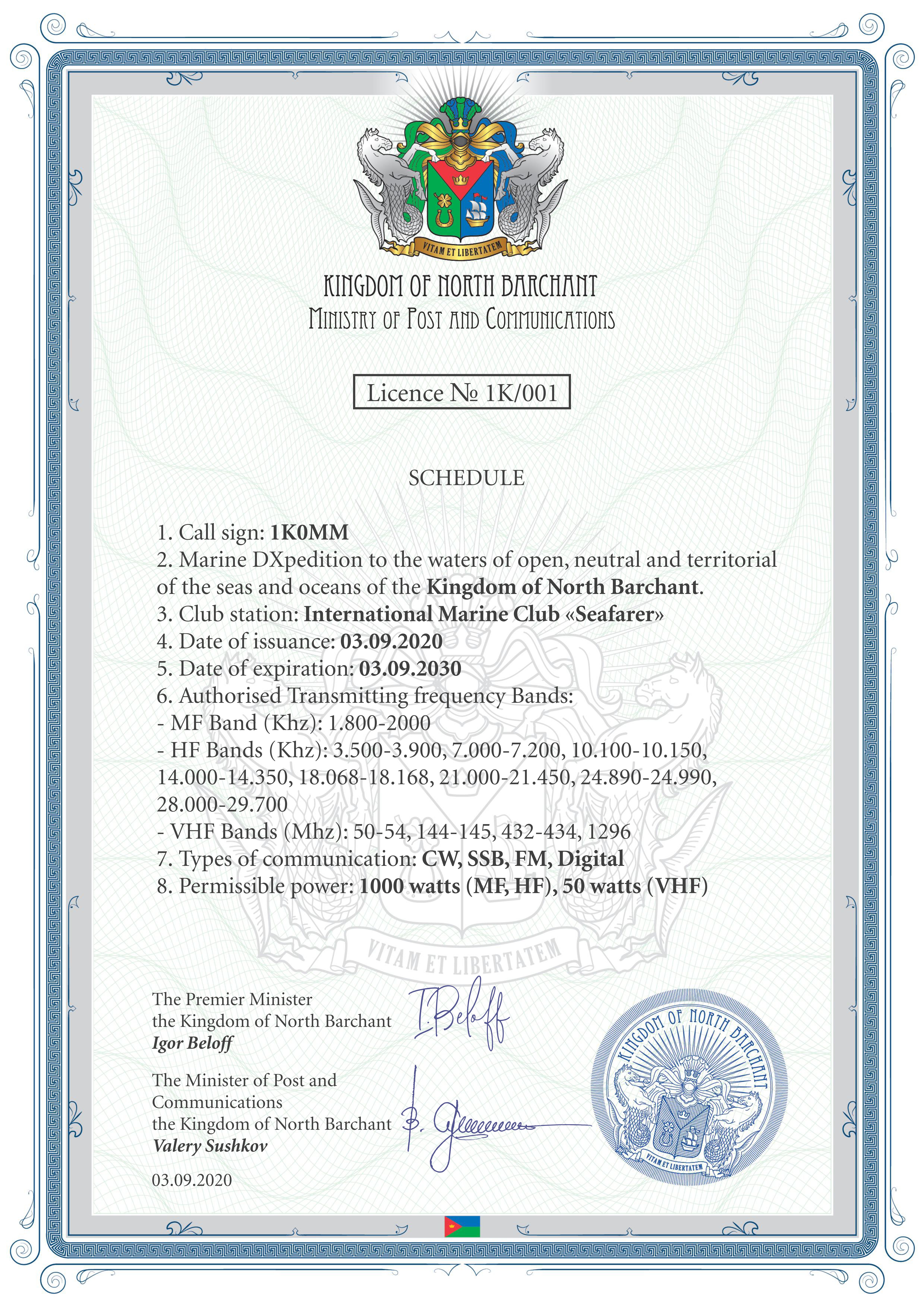
The United Nations Law of the Sea Convention was signed in Montego Bay city in December 1982 and took effect on November 16, 1994. It contains 320 articles and 9 annexes, was signed and ratified by 168 countries and the European union.
Historically, the space of seas and oceans are at the service of humankind as a stage for various activities (navigation, extracting living and non-living resources, research and development, etc.). In the course of these activities, states and international organizations enter into relations with each other, which are regulated by legal regulations, interdependent and constituting the area of international legal regulation called international Law of the Sea.
1K0MM license is the first and, perhaps, the only case-phenomenon throughout the history of radio amateur movement development when the official administration of the Post and Communications Department of KNB awards and issues radio amateur license for working on air solely shipboard in the water area of sea open, neutral and territorial waters.
The call signs with 1K prefix can be issued by the Post and Communications Department of KNB over claims of individuals who are the citizens of KNB or recognize the independence and sovereignty of KNB and should be used by the radio fans who work shipboard in the water area of sea open, neutral and territorial waters, as well as for the purpose of supporting around-the-world and other sea expeditions.
Respecting world countries’ local laws, as well as the regulation of RU и and CEPT international organizations, the use of KNB call sign with 1K prefix in the territory of the continental part of other countries using a slash (for example, SM/1K0MM) is not recommended, except for working on air from the “fifth ocean” broadside on aircraft, 1K0MM/AM.
The Post and Communications Department of KNB disclaims the fact that KNB radio stations with 1K prefix could be considered acknowledged ham programs DXCC, R-150-S and others, however, it will make efforts to make 1K prefix eventually considered one of the relevant international organizations such as IARU, CEPT or ARRL, and will try to become a member of ITU in the short term.
And maybe it’s high time to consider the ham activity of /MM from the sea and oceans for diploma programs of DXCC, R-150-S and others a separate country called World ocean, which covers almost 70,8% of earth surface and also, probably, the /AM activity from the air space of the “Fifth ocean” broadside on the plane, helicopter, air balloon or airship?! Well, why not?!
Throughout many decades there were cases of using radio-amateur prefixes of such experimental, undistributed, and inaccessible types on radio amateur air that are not recognized (or yet not!) at the international level, so our example is not the first that worked its way up. Besides, some of them were recognized under the DXCC program, and others officially became members of ITU. Let’s refer to the history of the phenomenon of issuing these call signs.
Among examples recognized at the international level (valid for DXCC):
1A: The Sovereign Military Order of Malta
Knight religious order of the Catholic Church in Rome, Italy. The world’s oldest order of knights. The Order of Malta has the status of organization-observer under the UN and in the Council of Europe. It has diplomatic relationships with 107 states maintained with the help of numerous ambassadors.
Activity: 1A0KM, 1A0PS, 1A0C, 1A4A.

1B: Blenheim Reefs.
The reef is a partially submerged atoll structure in the Chagos archipelago in the Indian ocean. It includes coral reef Baxio of Pradaxa in its Southeast area, and another completely submerged part. It is located in the North-Eastern part of the Chagos archipelago.
Activity: 1B9WNV, Op. W9WNV (1967).
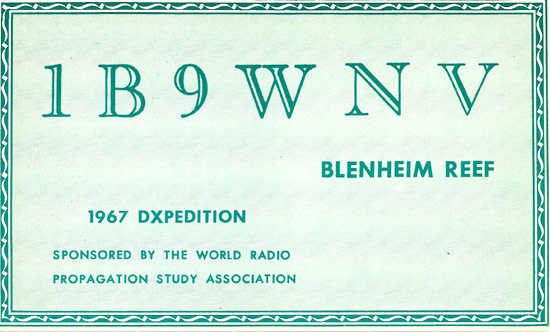
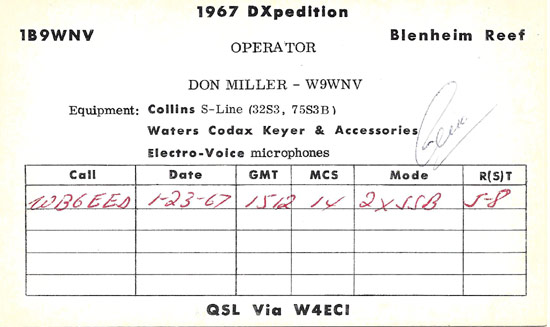
1G: Geyser reefs.
The reef is located 110 km northeast of Mayotte, 122 km southwest of the Glorieuse Islands, and 200 km Northwest of the coast of Madagascar. An almost completely submerged coral reef in the North-Eastern part of the Mozambique channel.
Activity: 1G5A, Op. W9WNV (1965, 1967). Recognized on DXCC from May 4, 1967 to February 28, 1978. Recognized on IOTA AF-071 until 2005.
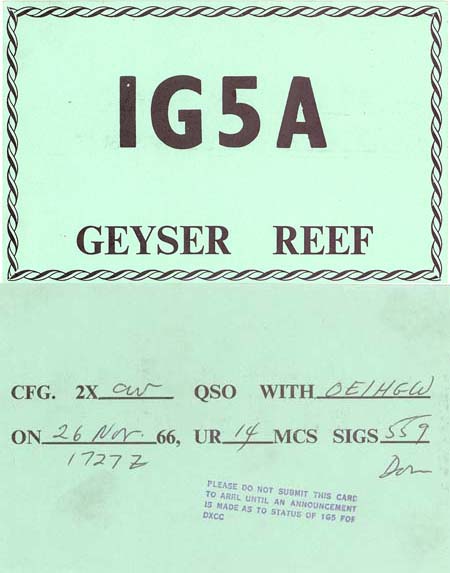

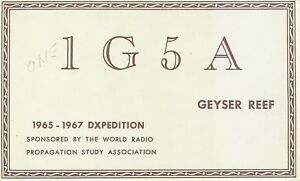

1S: Spratly Islands.
An archipelago in the southwestern part of the South China sea. The Islands have no permanent population, ports, or harbors, but there are four airports. Six states dispute territory of the Islands: Vietnam, China, Taiwan, Malaysia, the Philippines and Brunei (listed by the degree of presence). Despite their tiny size, the islands of the archipelago are important in terms of their presence in the region. Also, research indicates the presence of a significant amount of oil and gas. About 45 islands are occupied by relatively small military contingents from Vietnam, China, Malaysia, the Philippines and Taiwan. The Brunei fishing zone includes the southern reef, but Brunei has not made any official territorial claims. Without taking a position on the claims of those involved, these islands are recognized by ARRL for the DXCC program.
Activity since 1990: 1S0RR, 1S0XV, 1S1A, 1S1CK, 1S1DD, 1S1RR, 1S6SI. Now 9M0, DX0 or BV9.
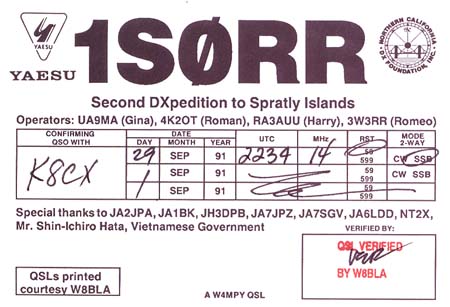
1M: The Minerva Reefs.
The Republic of Minerva is an unrecognized micro-state proclaimed on the Minerva coral reefs south of the Fiji Islands on January 19, 1972. The founder of the Republic was an American millionaire of Lithuanian origin, Michael Oliver. They are a group of two submerged atolls located in the Pacific ocean South of Fiji and Tonga. In 1973, Michael Oliver removed President Davis from office. In 1982, Davis and a group of Americans again tried to establish an independent state on Minerva, but they were again expelled by a branch of the Royal Marines 3 weeks later. For now, Davis continues to consider himself the President of Minerva. A group calling itself the "government in exile" considers Minerva a "Principality", a non-hereditary constitutional monarchy. Removed from the DXCC list on July 16, 1972.
Activity: 1M4A (1966)
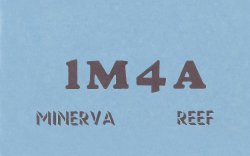
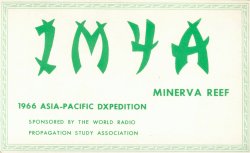
8Z5: Neutral zone Kuwait-Saudi Arabia
The border between Kuwait and Saudi Arabia, established in 1922, defined the neutral zone. In 1966, the two countries decided to divide this territory. The decree was signed in December 1969 and was later removed from the DXCC.
Activity: 9Z3AA, 8Z4A, 8Z4/HZ1AT; HZ2AMS/8Z5, HZ1AT/8Z4, HZ1BS/8Z4, HZ3TYQ/8Z4, 1964-1966.
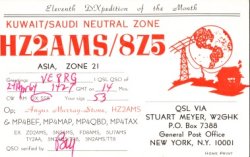
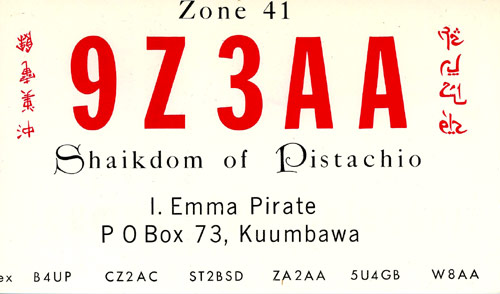
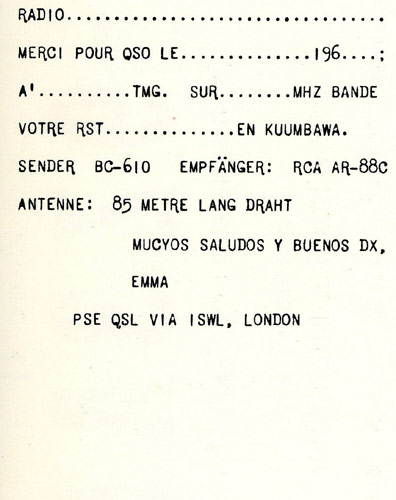

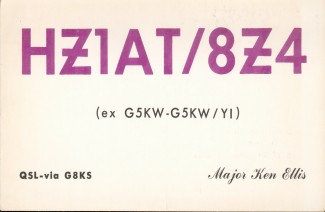

S0: Western Sahara
Disputed territory in North Africa. It borders Morocco in the North, Algeria in the northeast, Mauritania in the East and South, and the Atlantic ocean in the West.
Activity: S0RASD, S01A, S0S, S01MZ, S01WS.

Z6: Kosovo
Partially recognized state in South-Eastern Europe, on the Balkan Peninsula, in the geographical area of Kosovo.
Activity: various Z6 stations.

Examples not internationally recognized (not valid for DXCC) include:
1B: Turkish Republic of North Cyprus
A partially recognized state that occupies the North third of the island of Cyprus. From 1975 to 1983, the Turkish state entity that existed here was called the Cyprus-Turkish Federal State. Recognized only by Turkey.
Activity: 1B1A, 1B1AB, 1B1AD, 1B1NCC, 1B4KA, 1B9S, 1B1/OE5GML, 1B/DF8AN, 1B/DJ6SI, 1B/DK7ZZ, 1B/DL6NBR, 1B/KU0J.
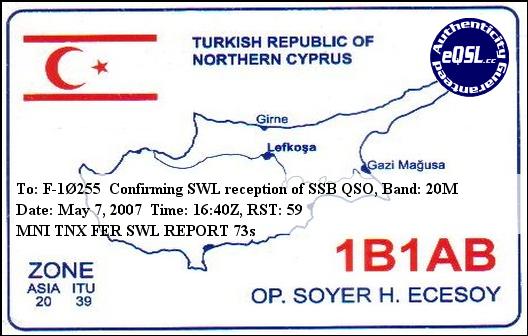
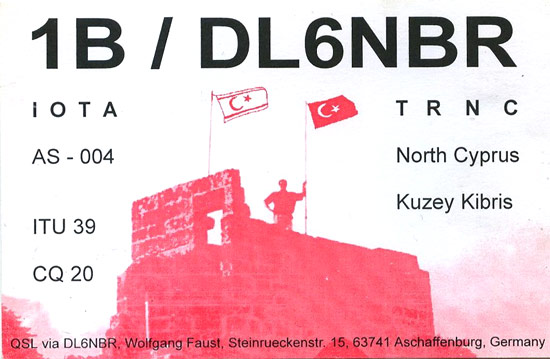
1C/1X: Militarized Chechnya
After the declaration of independence, Chechnya became a de facto independent republic, but it was not recognized by any state in the world, including Russia. From 1991 to 2002, there was a military and interwar crisis.
Activity: 1C0ZZ (1994); 1X5AA, op. RW6PA (1997-1998); 1X1AO, op. UA6WAR; 1X1AU, 1X1AX.
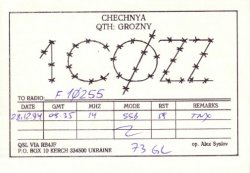

1N: Marco's Neutral zone
It was a narrow strip of land between Colombia and Brazil. From the 1930s until 1969, this piece of land was called Marco and "Tierra del Fuego" or "Land without man". It was named after a mistake in a survey conducted in the 1930s after an armed border dispute in the region.
Activity: 1N2A, op. TI2CF, HK3VA and TI2CMF (1969) Colombia, Marco Neutral Zone.

1P/T8/T0/0S: Principality of Seborga
A virtual state, declared in 1963 by the inhabitants of the village of the same name in the Italian administrative region of Liguria, near the French border.
Activity: 1P0U op. DL7CM; 1P0L op. DL8AAM; 1P0M op. DJ9ZB; 1P0N op. DL1BX; 1P0P op. DK8KW; 1P0W op. DK2WV; T88A, T888; T00SW (op. DL1JBN, DL3JSW), T09T (1995), T00U, T00CW, T00MH, t00pb, T00RM (1996-1998); T00PB, T00XX, T01A, t00vx, T00XL, T02X, t09bdx (1997); t03hk (2010); 0S0C (1994); 0S1A (1994).
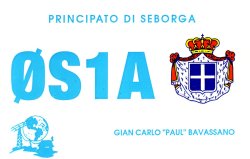


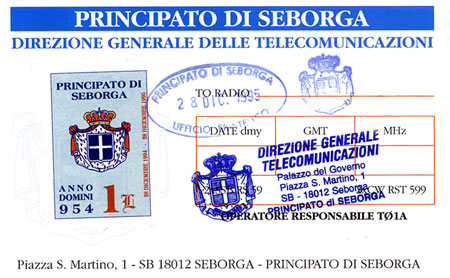
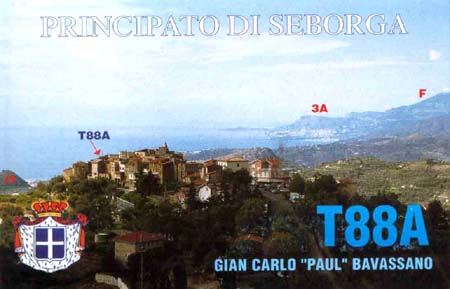
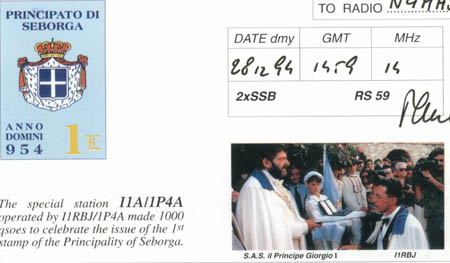

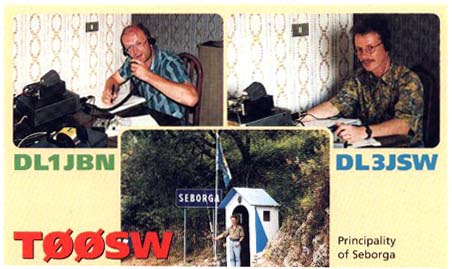
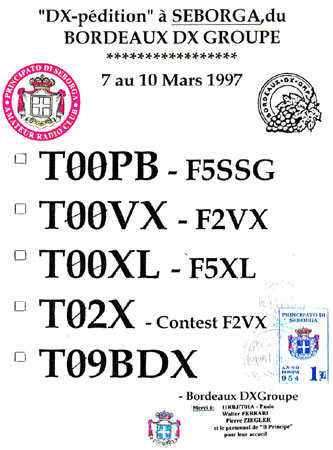
1SL/S1: The Principality of Sealand.
A virtual state was declared in 1967 by British retired major Paddy Roy Bates. It claims sovereignty over the territory of the former offshore platform of the British Navy in the North sea 10 kilometers off the coast of Great Britain and the territorial waters around. Bates declared himself a monarch (Prince) Sealand, and his family-the ruling dynasty. They and those who consider themselves nationals of the Sealand are engaged in creating and developing the attributes of the Principality, similar to the attributes of the States of the world (flag, coat of arms, anthem, passports, currency, postage stamps, etc.). The first Sealand Constitution came into force in 1975.
Activity: S1AH, S1AB, S1AS, S1AD, op. DF8AO, DK8KW, DL6PE, DL2NO (1982); 1SL1A, 1SL1J, op. K7CO (2000).
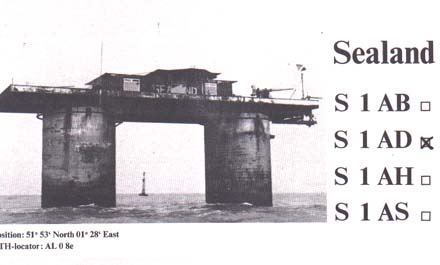
1L: The Free Republic of Liberland
A virtual state that claims an uninhabited, disputed land plot on the western bank of the Danube between Croatia and Serbia.
Activity: 1L4K, Op. Gregor Kočar, YU/S53SL/LSA, (2015). There is an amateur radio organization – LARA / Liberland Amateur Radio Association.
1U: The middle-earth Kingdom of Bir Tawil.
The territory, which borders Egypt in the North, and Sudan - in the West, South, and East. It got its name from a local water source (now defunct). Both countries renounce their claims to Bir Tawil; thus, it is terra nullius — "no man's land". In 2015, a Russian entrepreneur and radio amateur Dmitry Zhikharev declared himself the king of Bir Tawil.
Activity: 1U4UN, Op. RA9USU (2016, 2018).

1Z: Kawthoolei
Karen State, Kawthoolei. A national district in Myanmar. In fact, the territory is divided into an area under the control of government forces and the Karen military forces, who call their territory Kotholei, it is located in the Eastern part of Burma, it used this prefix during the military operations in the 1980s and 90s.
Activity: 1Z9A, 1Z9B, 1Z9D (1991), 1Z9E, 1Z9YL (1988).
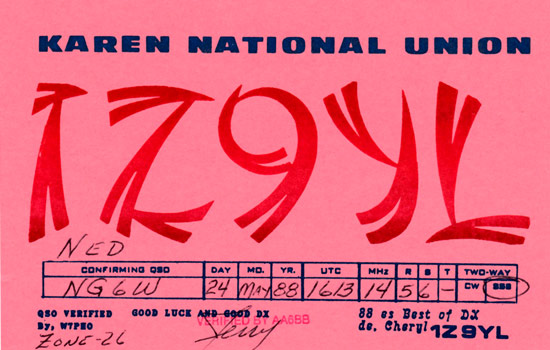
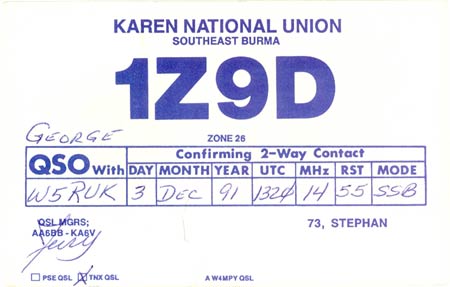
D0–D1: Donetsk People's Republic.
An unrecognized state entity in Eastern Europe, in the territory of Donbass.
Activity: many D0 and D1 stations.

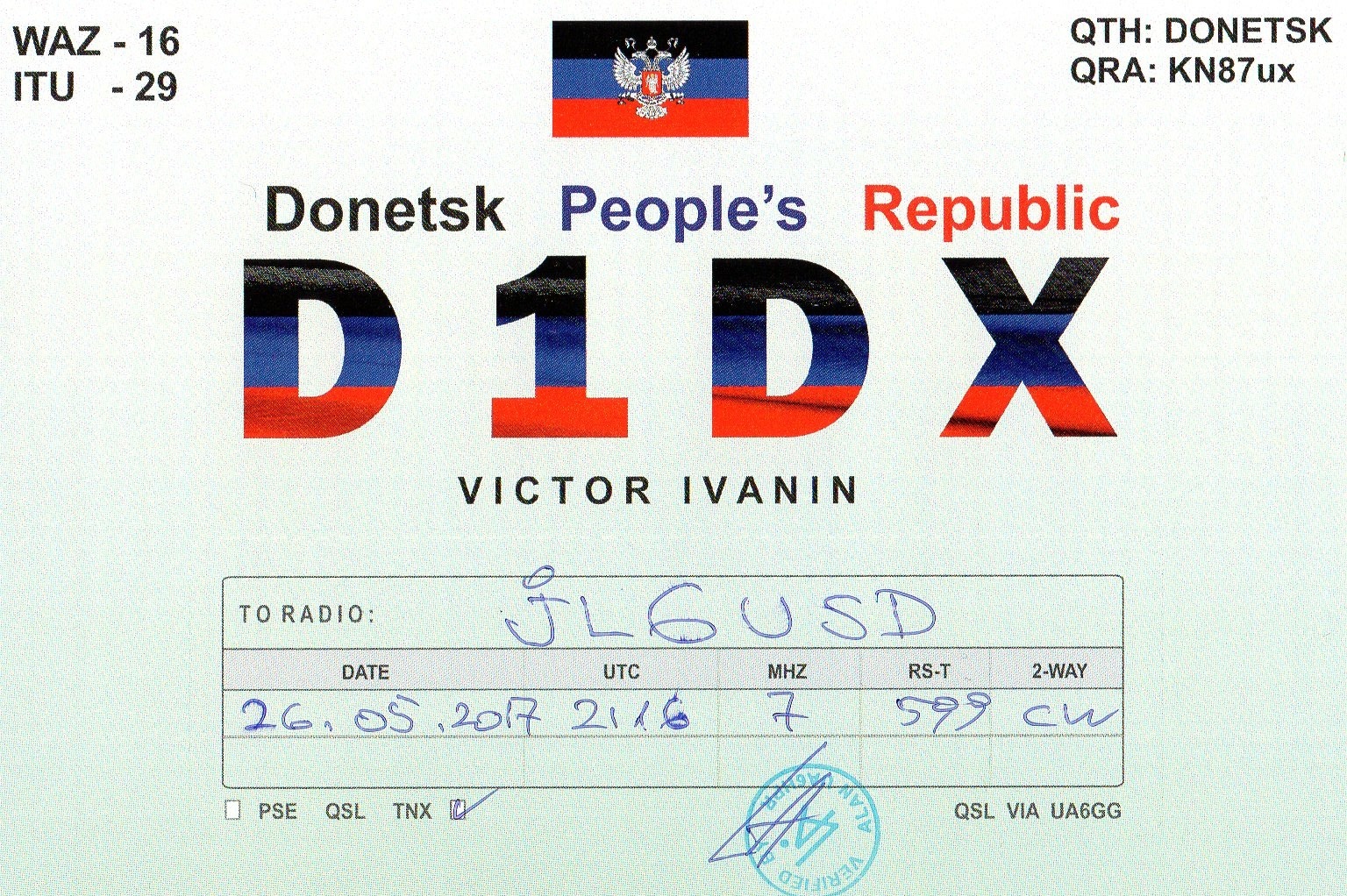
H5: Bophuthatswana.
One of the Bantustans of the apartheid Republic of South Africa. The state was founded in 1977. It was not recognized by the international community, except for some of the Bantustans such as Ciskei and Venda. It appeared as a result of the policy of apartheid in the Republic of South Africa.
Activity: H5FXT (1978), H5ABP (1983), H5ANX (1995).
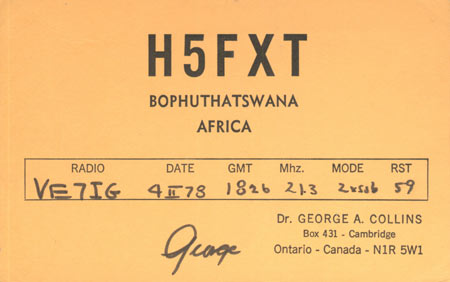

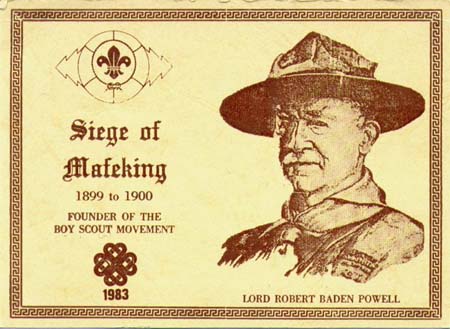
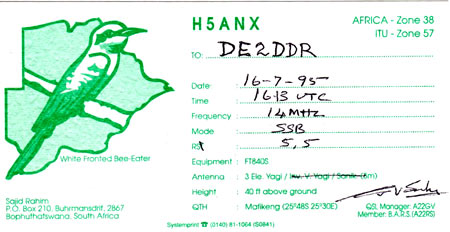

O1: Republic Of South Ossetia
Partially recognized state in Transcaucasia. The issue of the international legal status of South Ossetia is controversial: the independence of the Republic is recognized by five UN member States and by seven unrecognized and partially recognized States.
Activity: O19VB, op. UA4WHX (2015).

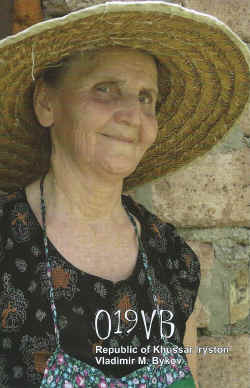
UF6V: The Republic of Abkhazia
Partially recognized state in Transcaucasia, declared in the territory of Abkhazia during the Georgian-Abkhazian conflict. The independence of the Republic is recognized by five UN member states and four unrecognized and partially recognized states.
Activity: various UF6V stations.

S4: Ciskei
One of the limited independent Bantustans that existed in South Africa during the apartheid era. Bantustans Ciskei and Transkei were intended for the Xhosa people. On 27 April 1994, Ciskei has once again become part of South Africa. Currently, the lands of former Ciskei are part of the Eastern Cape province.
Activity: S42A (1981), S42HZR (1983).
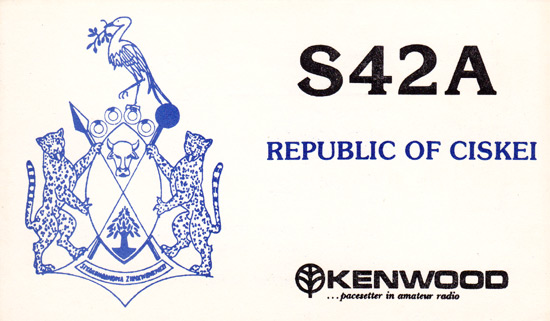
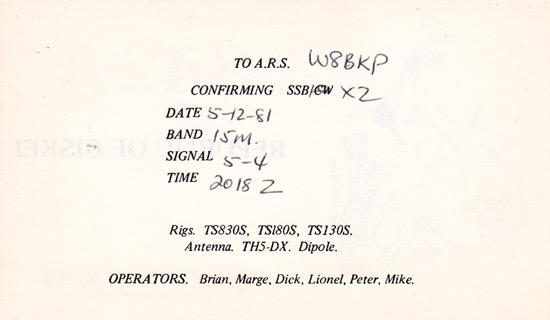

S8: Transkei
"Beyond the Kei" is the first of the former autonomous Bantu regions off the East coast of the Republic of South Africa. During the era of apartheid politics, Transkei had independent control as a Bantustan. After the end of the apartheid political system and the first national South African parliamentary elections on 27 April 1994, Transkei was abolished and dismembered, becoming part of the Republic of South Africa. Administratively, it was included in the Eastern Cape province.
Activity: S8AAD, S8AAW, S8HZR (1980), VE3FXT/S8.
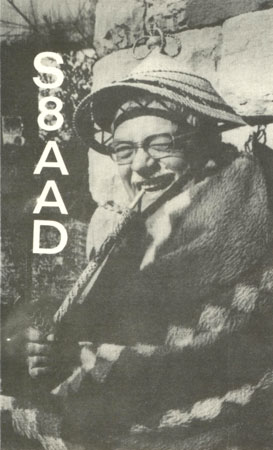
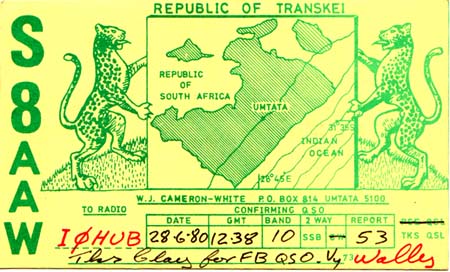
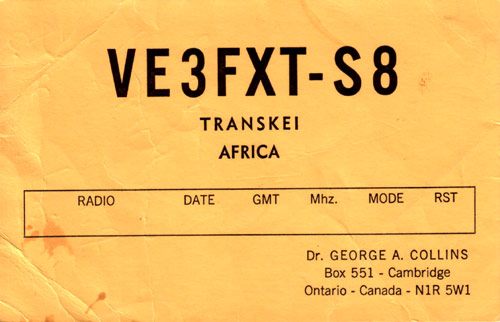
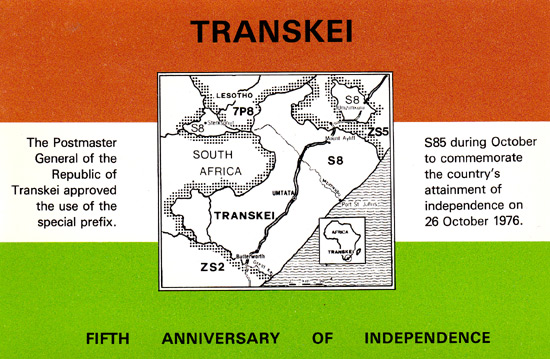
T1: The Pridnestrovian Moldavian Republic.
An unrecognized state in Eastern Europe, located on the left bank of the Dniester river with the Bender enclave on the right Bank. It borders Moldova and Ukraine.
Activity: T10VB, op. UA4WHX (2013). There is a Republican sports public organization "Union of Radio Amateurs of the Pridnestrovian Moldavian Republic".
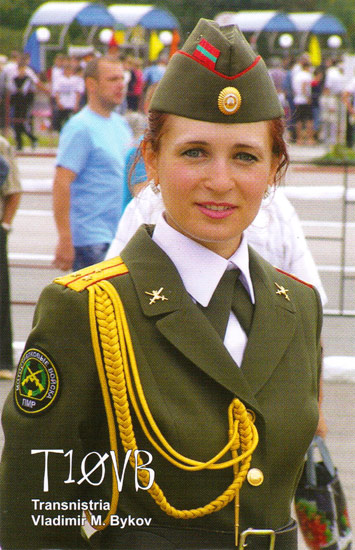
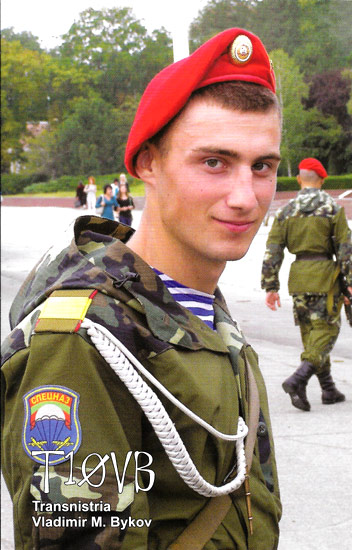
T4/V9: Republic of Venda
A nominally independent state (Bantustan) that existed from the 1970s to 1994 in the North of the Republic of South Africa (Transvaal province, now Limpopo province). This formation was intended for all South Africans belonging to the Venda people. On 27 April 1994, the territory of Venda was re-appended to the Republic of South Africa.
Activity: T4YL (op. WA6QFO, 1979), T4AHC (op. WA6QFN, 1979), T4A (1979), T4IND, T4VEN, 7P8BC/T4, ZS6ZS/T4, ZS6AEC/T4, ZS6RS/T4 (1979); WA2HZR/V9 (1984), V9ADC.
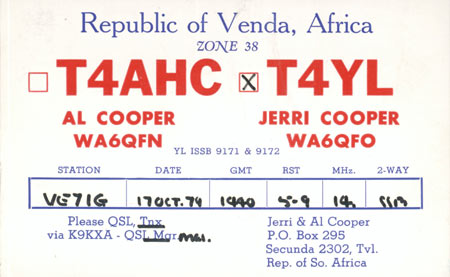

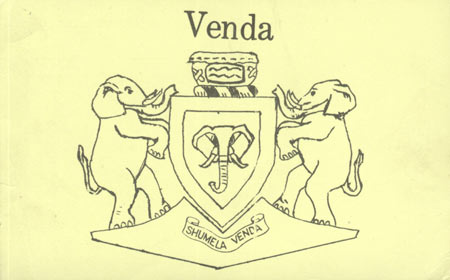
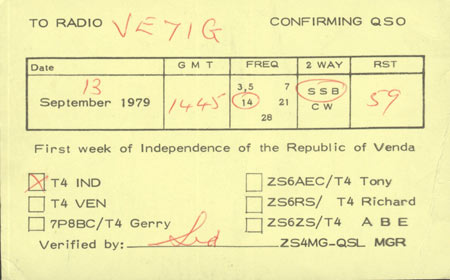

________________________________________

First 1K0mm expedition to celebrate the 5th anniversary of the Kingdom of North Barchant
In honor of the 5th anniversary of the Kingdom of North Barchant, the 125th anniversary of the invention of radio by Popov A.S., 160th anniversary of the city of Vladivostok, 180th anniversary of the first postage stamp and 200th anniversary of the first postal envelope, in September-October 2020б members of the international Maritime club "Navigator" with the participation of the Ministry of Sea & Bottle Mail, with the support of the coast guard Department of the border management of the Primorsky territory and the Tourist information center of the Primorsky territory will organize the Pacific historical and geographical postal film and radio expedition "Maritime heritage of the Primorsky territory" 1K0MM, which will be dedicated to navigators-researchers of the oceans and seas.
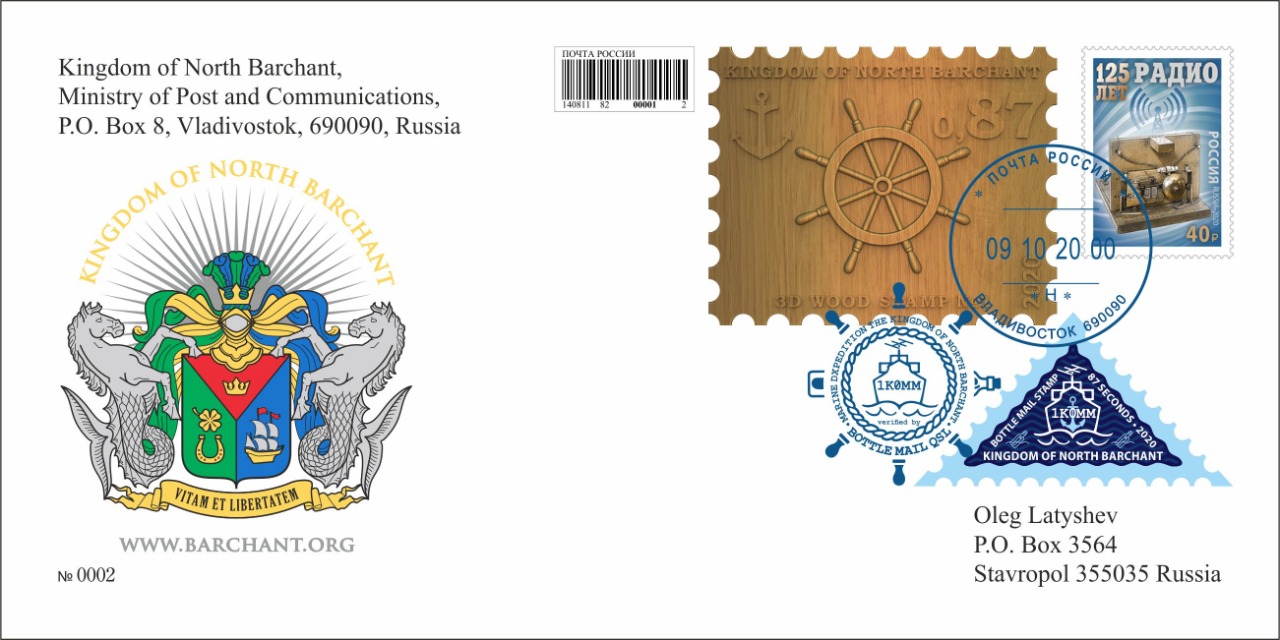

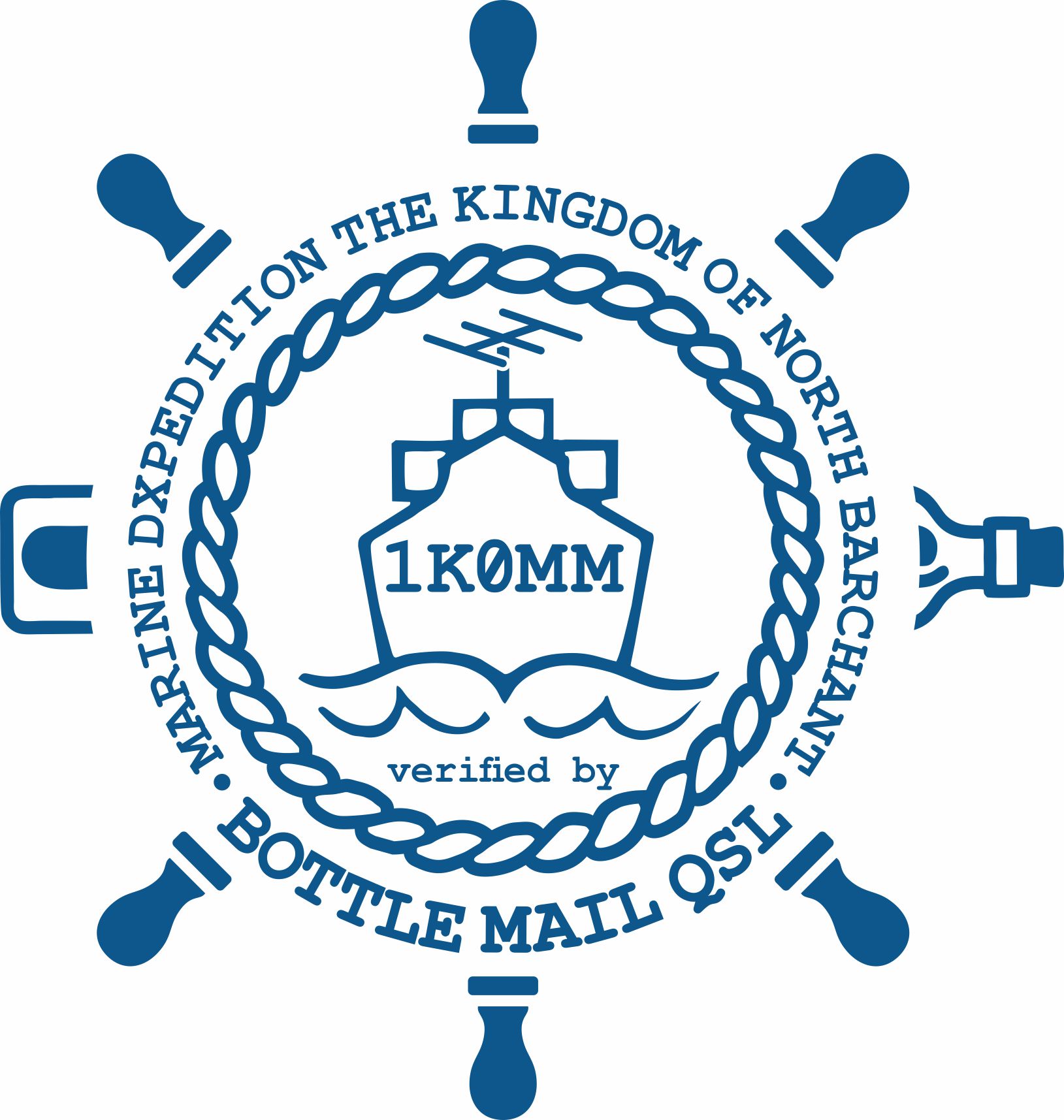
A unique 6-page expedition card-receipt BOTTLE MAIL QSL, a special expedition envelope, the world's first 3D wooden stamp and wooden postcard, an art stamp and a special franking, as well as a philatelic series "Navigator" (envelopes, art stamps, cards, maximum cards and hitching blocks) with images of 40 outstanding navigators and researchers of the Far East, including both famous personalities of the past and our contemporaries, many of which will be presented for the first time on philatelic products.
You can get special card-receipt BOTTLE MAIL QSL & 3D WOOD QSL by 1K0MM, envelope, art stamp, 3D wooden stamp, 3D POST CARD, philatelic kit in the series "Navigator" on request by email: hamradio@seafarer.world


6-page BOTTLE MAIL QSL
The 1k0mm expedition will use the unique Neptune mail - BOTTLE MAIL QSL.
BOTTLE MAIL QSL is an amateur radio receipt card using "Bottle mail", which is a documentary confirmation of the fact of a radio communication session (QSO) or observation (SWL) between two radio amateurs and a "Bottle message" thrown into the open sea with information about the radio communication session. The name QSL comes from an amateur radio Q-code meaning "your information or card received".
BOTTLE MAIL QSL is the first and only receipt card in the world, which was invented and first presented to the world radio community in September 2018 by the Ministry of Sea & Bottle Mail (RM0L / MM), which is owned by more than 50 radio amateurs from Russia, Germany, Australia, USA, Japan, and other countries.
BOTTLE MAIL QSL has its own certificate with an international registration number from the Ministry of Sea & Bottle Mail, translated into 5 languages: English, Russian, Chinese, Japanese and Korean. If the "Bottle message" is found, each holder of such a unique QSL card (the 1K0mm receipt card has its own unique numbering) will receive information about the bottle MAIL QSL migration (by whom, when, where it was found and which sea route it passed) in the form of a special bottle MAIL QSL AWARD diploma, which is sent to all correspondents who are the owners of this unique receipt card.
Who are radio amateurs?
Amateur radio allows you to combine the passion of the hunter on the air and the passion of the collector of different countries and rare territories, makes you engage in design, requires the ability to speak various foreign languages, encourages you to get acquainted with geography and radio technology, learn Morse code and digital communication...
Amateur radio communication on HF and VHF is a communication service used for self-improvement purposes, for mutual communication and technical research carried out by radio amateurs (do not mistake for radio hooligans!), i.e. persons who have the necessary permission (certificate or license) and are engaged in radio engineering solely out of personal interest and without deriving material benefits (from the radio regulations).
Amateur radio stations can be used individually or collectively. An individual radio station belongs to a particular amateur radio operator, is installed at his home and only he has the right to work on it personally. A collective radio station is installed either in the organization's premises or at the home of an amateur radio operator (family).
The total number of radio amateurs in the world today reaches more than 3 million people, and about 40 thousand people in Russia. The youngest members of this army are less than eight years old, the oldest are over a hundred years old. Radio sports are popular among presidents and kings, politicians and artists, military personnel and housewives, schoolchildren and students, workers, and entrepreneurs. At various times, such radio amateurs as King Hussein of Jordan, King Juan Carlos of Spain and the President of Argentina, or musician Joe Walsh, a member of the rock band EAGLES, co-author of the famous hit "Hotel California", and many others were interested in amateur radio.
Almost all 20th-century expeditions used radio stations to communicate with the outside world. Suffice it to recall the polar expedition "North Pole-1" and radio operator Ernst Krenkel with the call signs RAEM and UPOL, the sea expeditions of Tur Heordal on the "Tigris" and "RA" with the call sign LI2B and the sea expeditions of Jacques Yves Cousteau on the "Calypso" ship... Even today, in the days of the Internet, the famous polar explorer Vladimir Chukov uses the call sign of the route groups of the Arctic Expedition center – R3СА (R3CA/ANT, R3CA/0). The famous Russian traveler Dmitry Shparo had his own personal call sign-UA3AJH and always took radio operators on his Arctic expeditions. The world-famous famous Russian traveler Fyodor Konyukhov used the amateur radio call sign in his sea circumnavigations (R0L/mm) and he is himself the owner of the Amateur radio call sign R0FK; renowned Russian traveler captain of the yacht "Apostol Andrey" Nikolai Litau used in all his sea circumnavigations the amateur radio call sign R3al / mm and he is the owner of the amateur radio call sign R3CN, has his own personal call sign RA3TND, and another Russian traveler - Nikolai Efremov, very often uses a short-wave transmitter in his expedition routes…
Today, Russian amateur radio travelers (they are also called radio expedients) continue the glorious traditions of their predecessors and organize hundreds of unique radio expedients to uninhabited islands and rarely accessible countries, to deserts and the highest peaks, to the North and South poles, broadcast from the board of ships and aircraft, balloons and even submarines.
Even the first cosmonaut, Yuri Gagarin, had an amateur radio call sign-UA1LP, and today every Russian cosmonaut and foreign astronaut in the International space station (ISS) gets an amateur radio call sign without fail, using VHF radio communications as part of various international orbital radio expeditions (RS0ISS and NA1SS). Sergey Samburov, RV3DR, great-grandson of the scientist K. E. Tsiolkovsky, has been the head of amateur radio activities on the ISS for many years, and it is he who takes amateur radio exams for all Russian cosmonauts.
However, don't think that short waves are only for men. Every year, short-wave amateur radio finds more and more fans, not only he-fans, but also she-fans (YL), which number increases every year.
What attracts people of such different professions and occupations to amateur radio?
This is the unpredictability of a unique hobby: including a radio station, a radio amateur sometimes does not know who will be his next correspondent – a player of the Ukrainian national football team, a climber from the top of Kilimanjaro, a radio operator from the air board of a Boeing 737, a monk from Athos or an expedition to Pitcairn island in Oceania.
This is a multi-faceted hobby: working with long-distance or rare radio stations, participating in competitions, fulfilling the master of sports standard or the conditions of various diploma programs, designing radio equipment or assembling antenna-mast structures, using digital types of radio communication or learning Morse code... and, perhaps, today only an amateur radio operator can make an exciting "round-the-world trip" and visit all the continents of the world at once, contacting radio correspondents on short waves.
87! “Fair wind and seven feet under the keel!”
Welcome aboard the expedition ship "Maritime heritage of Primorsky Krai"!
See you on the air!